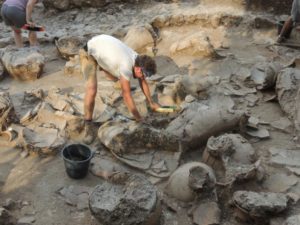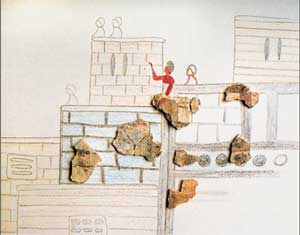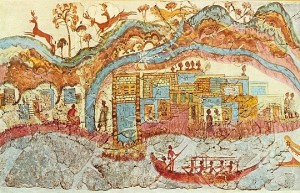Archeological Detective Work

Recently, at Tel Kabri on the Mediterranean coast in Israel, archeologists found an ancient wine cellar. The media got excited about the well-aged traces of wine. It surely is a great find. But now for some historical detective work.
The fact is that the wine was not just found anywhere. Tel Kabri is one of the few places in the Middle East where Minoan wall paintings have been found.

The Minoans were an ancient civilization based in what is now Greece. They basically got wiped out with the eruption of the volcano Thera, modern Santorini. According to some scholars, the eruption of Thera coincided with the Biblical exodus.
It seems that prior to the exodus, there was a Minoan presence in Canaan at Tel Kabri. The wine fits into this context because wine was central for much of ancient religious ritual, sometimes used – e.g., with the cult of Dionysius – to fuel orgies.
So what do we compare the Minoan wall paintings at Tel Kabri to? Well, remarkably enough, similar wall paintings were found in Avaris, ancient Egypt in the area that the Bible calls “Goshen” i.e. the area of the Israelites. Interestingly, Professor Manfred Bietak who has been digging at Avaris for over thirty years, has identified this city with the capital of the ancient “Hyksos”.
Who were the “Hyksos”? According to scholars, they were Semites from the area of Canaan. They were a mixture of Canaanites and Israelites and, as the archeology proves, there were also Aegeans among them, including the Minoans. The most famous “Hykso” i.e. a Semitic ruler in Egypt, is the Biblical Joseph. “Avaris” sounds like a play on the Biblical Joseph’s name. The Bible calls him “Ish Ivri” in Hebrew i.e. “The Hebrew Man”. Avaris sounds like an Egyptianization of Joseph’s name. Since he ruled the area, it makes total sense that the city would be named after him.
On the island of Santorini, archeologists discovered perfectly preserved 3,500 year old Minoan wall paintings depicting a city in the Nile delta that fits with Bietak’s reconstruction of Avaris. In other words, here we have a picture, complete with elegant ladies on fancy balconies, of the Biblical capital of “Goshen”.
What does all this mean? It means that we are finding the cultural context for the Biblical exodus. The Bible says that the people that left Egypt and followed Moses to the promised land were Israelites and a “mixed multitude”. The Hebrew is “Erev Rav” i.e. a mixture of nations that actually constituted a “multitude” or “majority”. Put differently, the Bible plainly tells us that the people who followed Moses were a mixture of nations that fused into the Israelites at Mount Sinai – and became one people.
We can now start recreating the world that the Biblical exodus took place in. It wasn’t just made up of Egyptians and Israelites, but of Canaanites and even Minoans.
We can look at archeological remains as dead matter, or we can be archeological detectives and link the wine to the paintings, and the paintings to a city, and the city to a people, and the people to the greatest story ever told.


